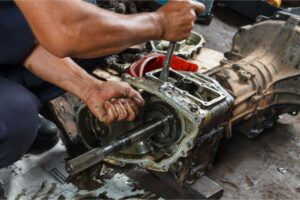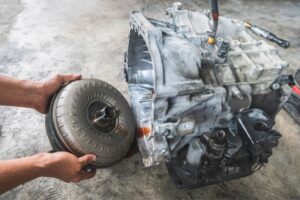If you own a 2008 through 2016 Ford Escape and are experiencing transmission problems you probably want them fixed as soon as possible before you’re left stranded on the side of the road.
The 2008 through 2016 year model Ford Escapes are notorious for transmission problems early on and if you don’t know what the symptoms are you might miss them until it turns into a serious problem.
Suppose you don’t fix the problems as soon as the symptoms start; your car is left much more vulnerable to failure at any time and at any place, which can be dangerous.
Fortunately, fixing a transmission problem in a Ford Escape has been done before and will inevitably be done time and time again.
For any vehicle owner, transmission problems can be some of the most complicated problems you have to deal with.
If you want to keep yourself from spending too much money on a repair, you should know what to look for; otherwise, the source of the problem and the cost of repair won’t add up.
Some of the common problems are:
- Delayed Shifts
- Low Fluid Level
- Gear Grinding
- Worn Out Gear Synchronizers
- A Clutch Pedal Level Issues
- Transmission Going Into An Unintended Gear
- Transmission Fault
- Vibration
- Burning Smell
- Slipping Transmission
- Failed Needle Roller Bearing
Let’s find out each issue and learn some other tips I have also provided below!
Table of Contents
- 1 The 11 Most Common Ford Escape Transmission Problems
- 1.1 1. Delayed Shifts
- 1.2 2. Low Fluid Level
- 1.3 3. Gear Grinding
- 1.4 4. Worn Out Gear Synchronizers
- 1.5 5. A Clutch Pedal Level Issues
- 1.6 6. Transmission Going Into An Unintended Gear
- 1.7 7. Transmission Fault
- 1.8 8. Vibration
- 1.9 9. Burning Smell
- 1.10 10. Slipping Transmission
- 1.11 11. Failed Needle Roller Bearing
- 2 10 Signs Of Transmission Problems In A Ford Escape
- 3 The Worst Ford Escape Model Years
- 4 Ford Escape Recall
- 5 How Much Does A Ford Escape Transmission Replacement Cost?
- 6 What Is The Lifespan Of A Ford Escape Transmission?
- 7 Conclusion
The 11 Most Common Ford Escape Transmission Problems

1. Delayed Shifts
Delayed shifts can occur anytime your vehicle equipped with an automatic transmission attempts to shift gears.
It occurs due to a damaged body valve or transmission solenoid.
In extreme cases, it can make transmission unable to change to a certain gear.
To confirm this problem, look at the following issues:
- Clunking sounds whenever you try switching to reverse- consider looking into replacing the valve body or solenoid if you notice this sound.
- Look for delays when shifting from park to drive or from drive to park. It implies that the valve body is not working as required and thus should be replaced.
- If the transmission is shifting radically, it is often due to problems with transmission fluid or the valve body. It is good to have the two issues in mind.
These problems might not be that bad initially, but as time goes by, they worsen and can cause major damage to your Ford Escape.
2. Low Fluid Level
Just like with other vehicles, one of the common transmission problems with 2014 Ford Escape’s in particular are low fluid levels.
Low fluid levels make it hard for your Ford to escape shift gears. It is always good to monitor transmission fluid levels and make additions as necessary.
The most common time to check the transmission fluid level is during an oil change or gas fill up.
Transmission fluid should be changed after a mileage of 50,000 miles. If you haven’t changed your fluid by then, it is time to do it.
Suppose you suspect a low fluid level, confirm by checking the following:
- A vehicle with a damagingly low fluid levels will throw you back and forth as you try shifting gears in a jerking motion.
- Vehicles with low transmission fluid levels will also take more time shifting gears. Delayed gear shifting is not normal, and thus, wherever it occurs, it should raise suspicion of low fluid level.
- Low fluid levels are also manifested by overheating. Under normal circumstances, transmissions should not overheat; therefore, it is an indicator that something is wrong whenever it happens.
- A Ford Escape with low transmission fluid typically will not change gears as fast.
If you are experiencing any of these tell-tale signs, change your transmission fluid. Drain the old fluid and put in some fresh fluid.
Be sure not to flush the fluid since it can damage your transmission further if it is already experiencing problems.
3. Gear Grinding
Another major transmission problem, commonly seen in the 2008 Ford Escape, is the grinding of gears; it implies that your clutch isn’t releasing or the shifter has an adjustment issue.
Low fluid and oil levels can cause this problem, especially with manual cars.
4. Worn Out Gear Synchronizers
This problem only affects Ford Escapes with manual transmission systems.
Synchronizers make it possible for the gear you are shifting to spin at a speed similar to the gear you are shifting from.
This creates a smooth, uninterrupted shifting experience. Unfortunately, a worn-out gear synchronizer will lead to transmission failure if not rectified in a timely manner.
5. A Clutch Pedal Level Issues
A fault in the hydraulic system or linkage can make pedal engagement very low. To fix this, a simple adjustment or bleeding the system can be helpful.
On the other hand, a high-grabbing clutch can result from a worn-out clutch disc, pressure plate, or other transmission problems.
6. Transmission Going Into An Unintended Gear
This is one of the notorious 2008 Ford Escape transmission problems.
Problems with the manual lever sensor commonly cause it. In addition, it can be due to the wrong manual lever position.
For instance, your new 2008 Ford Escape transmission can go into limp mode if a sensor fails.
You can shift from one gear to another, but the PCM won’t identify which gear it is. Limp mode is a serious problem that should not be overlooked.
7. Transmission Fault
Your 2012 Ford Escape won’t move if it has detected a serious transmission fault. It will fail to move even with multiple attempts.
At the same time, you will feel as if you have run over something. The vehicle will often give you a notification stating, “transmission fault service now.”
8. Vibration
A Ford Escape can vibrate when accelerating beyond 35MPH and it is among the most common 2013 Ford Escape transmission problems. Issues with your torque converter cause it.
To confirm this diagnosis, check on the following:
- An engine shuts off whenever you put in gear. If this is the case, then there is something wrong with the torque convertor.
- Secondly, a damaged torque convertor is noisy, a loud whining noise coming from the transmission is a clear indicator that it should be replaced.
- A damaged torque convertor will make you feel as if you are driving on a rough road, making a ride feel bumpy, hence less enjoyable for everyone in the car.
Make sure that you never ignore those problems.
Suppose you just had your transmission replaced, then the problem may be related to poor installation methods, such as a tight fixation.
In which case, the installer should fix promptly.
9. Burning Smell
Whenever you notice a burning smell coming from your car, it is a clear indicator that you need to solve a specific imminent problem.
A burning smell can often be a result of fluid leaking into the clutch or transmission. Early identification of this problem is vital to prevent further damage and save the transmission.
In addition, the production of a buzzing sound is an indicator of a bad internal sealing surface, transmission fluid, or a malfunctioning valve seal.
10. Slipping Transmission
Transmission slipping is caused:
- Low levels of the transmission fluid
- A contaminated transmission fluid
- Lack of routine maintenance
In addition, transmission slippage can also be caused by wear and tear on the parts of the transmission.
Suppose your 2011 Ford Escape seems to rev too high when shifting gears, with a slipping transmission, this means your clutches might be burning out.
Worn-out crutches are the most common cause of transmission problems in a 2011 Ford Escape.
11. Failed Needle Roller Bearing
Needle bearings are small, light rollers that aid gears in automatic transmission torque from grinding.
If the needle transmission is worn out, there will be a grinding sound from your Ford Escape during motion; this will imply that your transmission gears are not moving efficiently; they may be prematurely worn out.
10 Signs Of Transmission Problems In A Ford Escape

Just like any car problem, detecting a transmission problem can save you money and prevent further damage.
It is essential to learn how to identify the warning signs of transmission problems and to act at speed.
Some of the common signs of transmission problems or failure are:
1. Refusal To Switch Gears
A Ford Escape with transmission issues will struggle with switching gears. At times, it will completely refuse to switch gears.
In many instances, refusal to change gears results from a low fluid level or a wrong transmission fluid.
2. Production Of A Burning Smell
A burning smell indicates that the transmission is overheating. In addition, a burning smell can be produced by old transmission fluid. Therefore, changing the fluid can be crucial.
The predominant cause of the burning smell is an overheated fluid which is vital for protecting this complex system.
After a fluid loses its lubrication properties with increased mileage, there is a buildup of damaging friction. This friction leads to a buildup of residues and sludge.
With time, these problems will lead to a complete transmission failure which is expensive to rectify.
Sometimes, a low level of transmission fluid is the problem. The low level can be due to leakages since it doesn’t lessen with use.
3. Dragging Clutches
A dragging clutch comes about when a clutch fails to disengage the clutch disk from the flywheel wherever you press on the clutch pedal.
4. Gear Slipping
If your car slips or loses traction when needed, then it might have a serious safety issue.
Suppose your gear slips in and out when you are behind the wheel, check and rule out problems in the transmission system.
A Ford Escape’s computer usually tells you when there is a shift from one gear to another.
It functions to tell your car when to send energy to the wheels. Therefore, wherever there is a transmission problem, the signal is not relayed correctly.
5. Fluid Leak
One of the most straightforward signs of transmission problems is leaking fluid. The transmission fluid is usually red.
You can notice the leaked fluid underneath your car in the parking lot or garage. Be sure to check the level of transmission fluid.
A leak of transmission fluid signifies a severe underlying problem since, under normal circumstances, the fluid isn’t supposed to leak.
Leaking transmission fluid can lead to a severe breakdown which is very insecure and expensive.
Sometimes, a leaking fluid is an inexpensive service that will require only the replacement of a leaking gasket.
However, if you do nothing, it will be a serious problem. Thus, do not ignore transmission fluid leakage, even if it is minimal.
6. Engine Light
The engine light on the dashboard of your Ford Escape can be a sign of both major and minor issues.
Therefore, wherever it is on, ensure you check the transmission and rule out any related issues. An engine light can help you diagnose a current or upcoming problem.
A Ford Escape’s engine has many sensors from which you can pick up transmission issues much more quickly than without them. These sensors send signals to your screen.
7. Production Of Neutral Sounds
If your Ford Escape produces any sounds when neutral, then it is an important sign of transmission issues.
It indicates that your car needs new oil or a replacement due to wear and tear.
8. Production Of Humming Sounds
Whining, humming, and clunking noises are abnormal; thus, wherever you notice them, ensure you consult any mechanic near you for assistance.
A car that produces unusual sound has some transmission problems. Although it is a minor sign, it can signify serious problems.
At times, the noise from your transmission can result from the breakdown of the transmission fluid, which keeps mechanical gears and components lubricated at all times.
When used for long, the fluid loses its protective properties; thus, friction will be inevitable. Increased friction will lead to the destruction of the automatic transmission system.
It is crucial to consult an experienced and qualified automatic transmission mechanic when you hear clunking noises from your Ford Escape.
9. Poor response
If your car doesn’t respond well when changing from drive to park and vice versa, then a transmission problem is probable.
10. Grinding And Shaking
Grinding and shaking are more common in automatic transmission. It is more dominant when changing gears and is often a sign of transmission issues.
Typically, an automatic transmission operates smoothly when shifting from one gear to another.
When problems start, these symptoms are insignificant but worsen with time and use.
Related: Why Won’t My Ford Escape Start?
The Worst Ford Escape Model Years

Regarding reliability, the worst models are 2013, 2008, and 2005.
The three models are known due to their transmission problems, like stopping to work entirely at 80,000 miles.
In the 2006 model, transmission failure can occur at 83,000 miles, requiring around $3,000 to replace.
Ford Escape Recall
In 2015, Ford had to recall certain Ford Escapes and Mariner Vehicles produced between March 2001 and September 2009. The recall was due to transmission-related issues.
All the cars recalled had 2.3 -3.0 liter engines that were rebuilt between June and July 2015. They had transmissions with faulty lever bolts, which hindered shifting.
The bolt could not be tightened, and thus the control lever was used to disengage with no warning, leading to transmission issues.
Whenever a lever disengages, you won’t tell the gear position of your vehicle.
Suppose this occurs while driving at high speeds; the gear position will show that the Ford Escape is in the parking position when it is driving.
This can cause a roll away, which can endanger the driver and other occupants.
How Much Does A Ford Escape Transmission Replacement Cost?

If you are determined to change or rectify your Ford Escape’s transmission, be ready to spend some money.
Acquiring a new transmission is very expensive.
Sometimes, you can spend more money on the transmission systems compared to maintaining the whole car.
On average, a used Ford Escape transmission can range from between $1,000 to $2,500. Labour alone can cost you 1,500 to 2000 $.
Ensure to take your car to qualified and experienced mechanics, be sure to avoid cheap rebuilds, which might be less effective.
Some of them work for a while and fail with time. In the long run, cheap rebuilds are expensive. Getting a manufactured transmission is the way to go.
What Is The Lifespan Of A Ford Escape Transmission?
In the past, Ford Escapes had a bad reputation due to the numerous transmission issues the vehicles had.
However, over the past few years, there have been seamless improvements by the manufacturers.
Nowadays, Ford Escape vehicles are solid, with a transmission lasting anywhere between 100k to 180k miles.
This is a good figure compared to the initial values; thus, the manufacturers have made many improvements.
Related: How Long Do Ford Escapes Last?
Conclusion

The commonest Ford Escape transmission problems are:
- Production of burning smells.
- Low levels of the transmission fluid.
- Slipping of gears.
- Dragging clutches.
- Poor responses.
- Failure to switch gears and many.
- Leaking fluids and others.
Sometimes, it is possible to diagnose and rectify transmission problems. For other problems, you will need assistance from professionals or official Ford dealers.
It is essential to try and diagnose your car before you take it to a dealer.
At times, you may notice that changing the transmission fluid is what you need to have your vehicle working as before.

I am Tahir Azam, and I have been writing amazing articles for TaxiHack for as long as I can remember. I know everything that is to know when it comes to automobiles and is always on top of industry news and developments. While I am not an expert by any means, I pride myself on knowing the ins and outs of many different problems and, of course, their solutions. The articles on our website are some of the best and well-researched content that you will find, and I spend countless hours making sure this remains to be true. This is why I ask you to take your time out and read some of my articles, especially if you find a topic that resonates with you or is something you are looking into. This way, you will find the perfect mix of information and tips on your desired topic. Learn more about Tahir.



